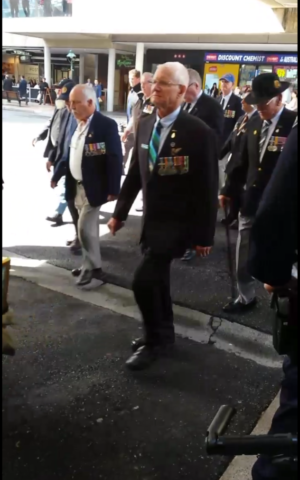Vietnam veterans remember those who did not come home

“It’s our day, today,” Vietnam veteran Ned Fisher said.
Mr Fisher served in the second tour in the tracker platoon with labradors in Vietnam.
“We were around the Long Tan rubber when they brought in the Long Tan Cross, that was in 1969, August 18th. The assault pioneers put the cross in the ground as the choppers brought it in.
“The veterans of Long Tan were around the cross and had a big service there, then we departed into the jungle again,” he said. “So it’s a big day for me.”
About 60,000 Australian soldiers fought the Viet Cong in South Vietnam (1962–1972), with 521 giving their lives. Australian’s largest loss was at the battle of Long Tan, Vietnam August 18, 1966. Outnumbered 20 to 1, 18 Aussie soldiers were killed.
Fifty years to the day men had gathered by the number, less than years past, at the Treasury Casino, Brisbane. Slowly they tricked in, all dressed with the medals adorning their chests as they proudly greeted their fellow mates.
Many stood alone, looking, waiting and watching to see a familiar face. Others huddled in small numbers lost in conversation.
For those who stood alone, one could only imagine their thoughts. Their empty expressions made one think “Have they lost all their mates; are they the last ones standing?”
Veteran Mr Fisher said: “Vietnam was the big thing. We were going to war.”
“Most of us that didn’t get the marble joined up. It was the thing to do – it made men out of us but at the same time it was a brain tease.”
Returning soldiers may have expected a welcome home from their fellow Australians, but this was not to be.
“We did our tours and came home at midnight,” Mr Fisher said.
“We flew into Darwin and we were told we weren’t going home in day hours. Like everyone else they kept us till 10 o’clock at night, then we got to Sydney, and there was nobody around. It was like see you later Jack. Then we departed on trains, buses, other planes, and went home.”
The scars of war surfaced not long after our men returned home, and a few of those at the Treasury Casino shared their inner torment that had plagued their lives, for some, it’s a road with endless pot holes that may never be filled.
The haunting recurring nightmares, the continuous drinking to numb it all out, not being able to be free from the horrors of war, killing an unknown enemy; women, men and children. The wife of Graham Rolley was one how lives with the memories of her husband – as if she was the one who had served.
“They did a lot of dreadful things to kids over there, because they were fighting kids as well.”
Mrs Rolley told Newsbytes of taking her husband to the Greenslopes hospital, and after seeing the psychiatrist, he said that he wouldn’t be coming home and that her husband was severely depressed and on the verge of suicide.
He took his own life.
Joan Nicholls’ husband Daryl suffered from bad dreams and coped by drinking alcohol especially with his mates but never talked about his time in ‘Nam.
“He wouldn’t admit that he wanted help, a lot of them did that, they wouldn’t admit that there was anything wrong with them. But later on when he was working in a civilian job he went and saw a psychiatrist,” she said.
Said Mr Fisher: “When you got back you worked till your late 50’s, then something went wrong in your head.”
“I’d wake up and my ex-wife would say that I was screaming and carrying on, that’s how it was in the head – the nightmares have depleted over the years, as you get older they’re still in the back ground. It was ‘bad news’ for us, especially the combat soldiers, bad news,” he said.

Peter Johnson
Another account came from Peter Johnson. He told Newsbytes he joined the 9th helicopter squadron in 1970 where he was the leading aircraft man. When he came home, he kept out of sight, and it wasn’t until 1987 that things started to change.
“The welcome home parade in ’87 that’s when everybody started to realise ‘Hey, these guys did do something’ and you’d get a sense of relief from within, which was good,” he said.
Noon was drawing near. More than 100 men (and a few women) gathered together on the main road standing in marching formation, steadying themselves and getting ready for the call. Every one of them silent, waiting, listening and standing at attention.
Then came the call and off they went. The military band dressed in their Highland tartan kilts started the pace with the sound of bagpipes and of beating drums leading the large procession of veterans.
Down the street they went, some in full swing and others trying to keep the pace, marching with their heads held high walking in the heat of the day.
Some bystanders, along the streets, yelled out “thank you,” clapping and honouring them as they made their way down towards Anzac Square to celebrate and to remember the memories of those who are no longer here.